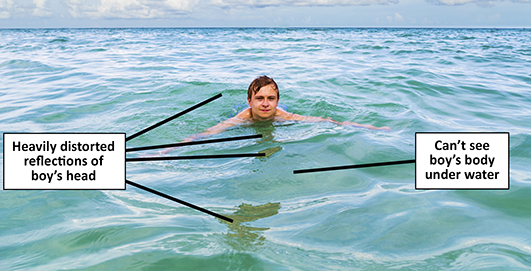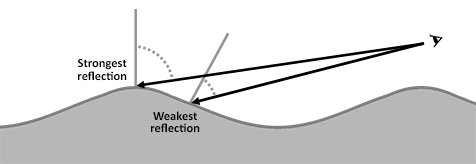When you look down into ocean or lake water, sometimes you can see objects or surfaces just below the surface while other times you can’t. In other words, in some places the water is transparent, but in other places the water is opaque.
At first glance, you might think the reason you can see the lake’s floor so clearly in the foreground is because the water is so shallow there. While the lake floor’s proximity to the water’s surface does play a role, there are other factors in play here. As an example, take a look at this photo of a boy swimming in the ocean. If objects and surfaces just below the water line could be visible, why can’t we see his lower body at all? Instead, we see only distorted reflections of his upper body.

It’s not that the water is choppy, or so full of algae that it’s opaque, or that the boy actually doesn’t have a lower body, or any of a hundred other reasons you could think of. The reality is that visibility changes with your viewing angle with regard to the water’s surface.
With all highly reflective, transparent surfaces such as water or glass, reflectivity changes with your viewing angle. When the angle reaches a certain degree, reflectivity is so high that it trumps transparency, giving you what appears to be an opaque, reflective surface. This means that water is more transparent when you look straight down at it, and less transparent (because of being more reflective) when you lower your viewing angle.

This quality of water and other transparent, reflective surfaces was discovered by physicist Augustin-Jean Fresnel in the early 1800’s. In computer graphics, many programs include a Fresnel shader that mimics this effect, making it easier to create realistic water and glass.
You can learn more about the Fresnel effect in Chapters 4 and 9 of Physics for Animators.
